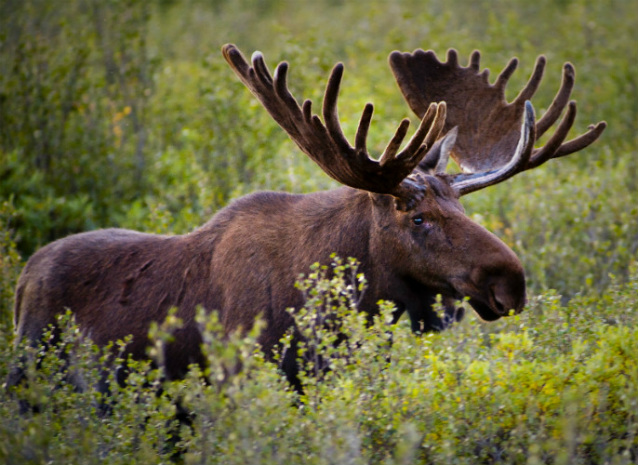
NPS photo
For most of the year, moose lead uneventful lives. Their time is largely spent feeding, resting, and moving from place to place. In Denali National Park and Preserve, they occasionally interact with bears and wolves, predators that they avoid, evade, or defend themselves against if they can. Moose typically avoid other moose during winter, spring and summer—they are not social animals that live in groups like caribou or Dall’s sheep.
But during autumn, moose become social and their lives change dramatically as the season for mating— also known as rutting—unfolds. Behaviors emerge that have been dormant for the past year as moose engage in rituals related solely to reproduction. Their uneventful lives quickly become hectic as bulls compete for breeding rights and cows seek out mating overtures from bulls.
The rut begins in late August after cow moose have spent the summer feeding (up to 13 hours a day), gaining weight, raising calves, and growing a new coat. Males (bulls) ingest enough nutrients to grow a new set of antlers and by late August have gained up to 250 pounds of fat and muscle. The rut lasts until early October.
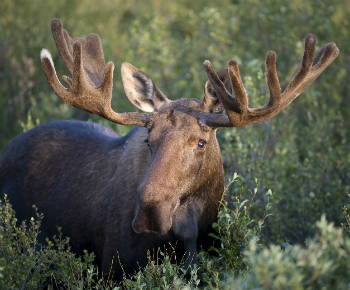
NPS photo
Dr. Vic Van Ballenberghe, now retired from the U. S. Forest Service, has studied the behavioral ecology of the moose rut in Denali since 1980. After about 1,000 hours of observations to describe all the behaviors that occur during the rut, and how frequently they occur, Van Ballenberghe developed and tested hypotheses to explain the function of these behaviors. Some questions about moose rutting behaviors have been answered. For example, do only the largest bulls mate with cows? He was able to determine that the large, highest ranking males—the victors of antler-clashing fights—performed 88 percent of the mating. The lowest ranking bulls were only able to mate with cows who had strayed from the groups being defended by the dominant bulls. And Van Ballenberghe has raised new questions. For example, how do rutting behaviors change in a hunted area when dominant bulls are removed?
Fall visitors to Denali have the exciting opportunity to easily observe moose between Miles 7-11. The park road bisects the sparse spruce forests and more open shrub tundra that moose prefer during the rutting season. Sometimes binoculars are not even needed to observe how moose interact during the rut, and to see—and hear—some or all of the associated behaviors.
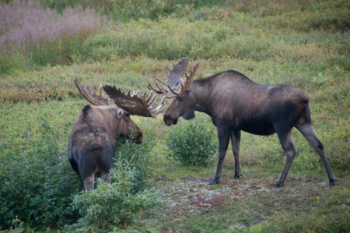
NPS photo
Sparring
At first, things progress slowly. Bulls with newly unsheathed antlers may lightly spar. Sparring is practice fighting where bulls engage their antlers and push back and forth, but there is no attempt to injure each other. Sparring begins in late August and continues during the entire rut and beyond, well into early winter. During his research, Van Ballenberghe confirmed his hypothesis that sparring involves learning about fighting and about rivals by observing that young bulls frequently sparred, at times for several hours a day, but older bulls rarely sparred.
Scent Marking
Soon after large bulls cease feeding, they begin scent marking. They first dig a shallow pit into the soil with their front feet. Then, they urinate in the pit and splash the mudurine mixture onto their antlers and neck. Finally, they lay in the pit. The bulls’ urine contains chemicals that help coordinate the fertility of cows that also wallow vigorously in the pits. Cows compete with each other and may fight in order to label themselves with the contents of the rutting pits. Bulls may also exhibit the flehmen response (lip curling, see photo) to gather and interpret female scents.
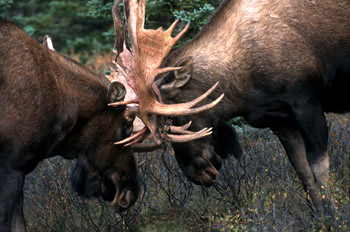
NPS photo
Fighting
By mid-September cows form relatively stable groups that persist until the rut ends. These may contain up to twenty-five females. Bulls must compete for breeding rights to the groups of cows. They do this by fighting. Unlike sparring, fighting is violent and bulls frequently suffer injuries ranging from minor to fatal. Of all the different rutting behaviors, fighting is the most exciting as bulls engage in epic battles that may last for hours. During fights, the sound of clashing antlers can be heard up to a mile away.
After a fight, evidence may remain in the form of torn up shrubs and tufts of hair or pieces of broken antlers. Fights are won by bulls that are larger, stronger, more agile and more experienced than their opponents. Denali’s bull moose do not become successful fighters and breeders until they are about seven yearsold, and they remain in their prime until 11 years-old. In contrast, cows first bear calves when they are three. Bulls decline after age 11, and most die by age 13. Cows may live until they are twenty.
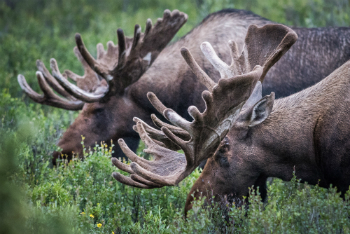
NPS photo
Mating
Mating begins by about the third week in September. Ninety-eight percent of cows observed over a 12- year period mated once a year, with only one bull. In contrast, bulls may mate with up to 25 cows each year if they can fight off challengers. Large males dominate smaller males and keep them away from cow groups. Yearling males perform less than 2 percent of all observed mating, mainly by finding cows away from groups.
Vocalizations
Bulls emit low-frequency croaks. Cows produce wavering moans that can be loud enough to be heard a mile away.
Moose are very active during the peak of the rut (late September, early October). Bulls dig rutting pits, fight, and mate. Cows wallow in pits, are pursued by bulls, and feed. By the end of the first week in October, the rut abruptly ends and moose return to their lives of eating and resting as they prepare for winter. Cows will carry their calves until the following May when births occur. All rutting behaviors cease until the following autumn.
Last updated: August 16, 2018
